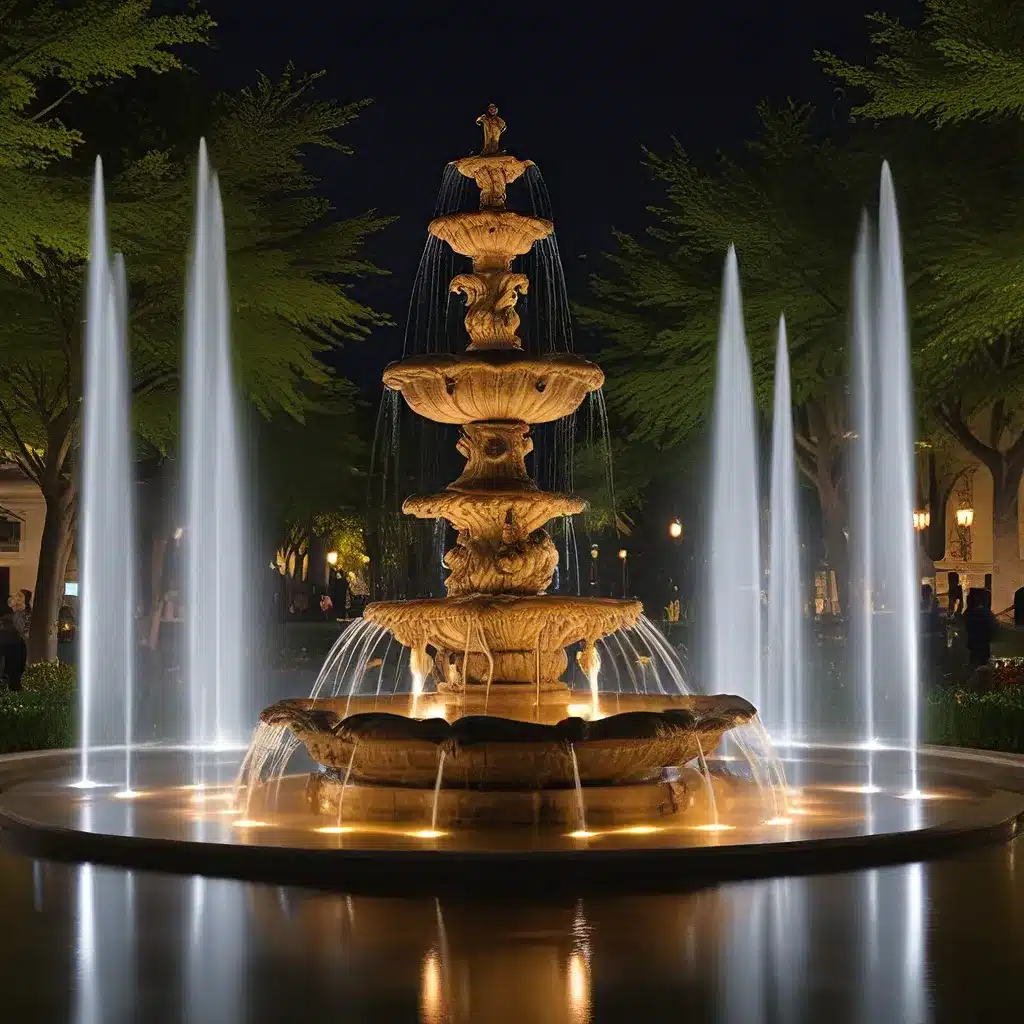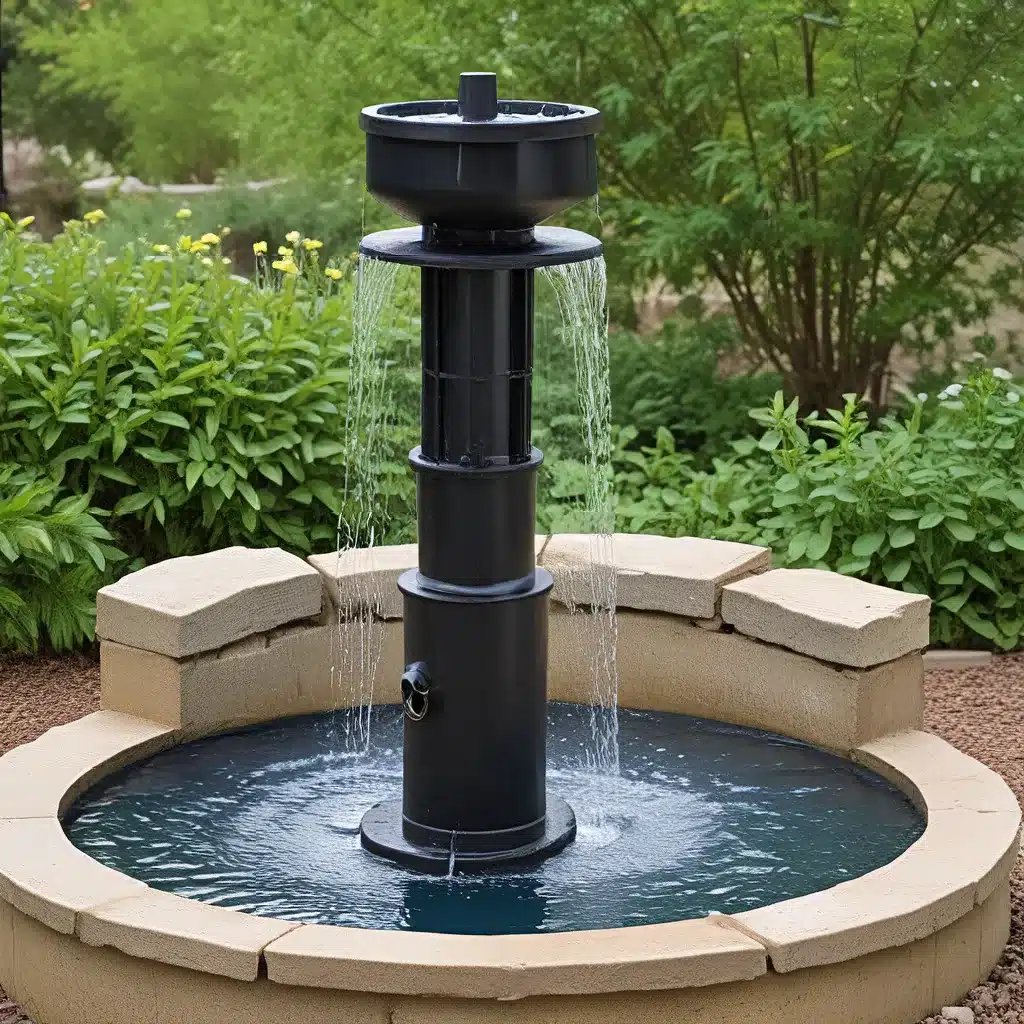
Fountain Design Essentials – Welcome to Fountain Lights
Fountain Design Essentials – Welcome to Fountain Lights

As someone who’s been tinkering with fountain projects for years, I can tell you that finding the right pump is crucial for achieving that perfect water display. Whether you’re building a backyard oasis or a grand public fountain, getting the pump specifications just right can make all the difference between a mesmerizing show and a disappointing dribble.
Before we dive into the nitty-gritty of pump selection, let’s first consider the size and scope of your fountain. After all, not every pump is created equal – they come in a wide range of sizes, flow rates, and power requirements.
If you’re working with a small, decorative tabletop fountain, you’ll likely need a compact pump that can handle a relatively low water volume. On the other hand, if you’re tackling a large, multi-tiered fountain, you’ll need a more powerful pump that can move thousands of gallons per hour.
The Lowes product guide is a great resource for understanding the different pump specifications and how they relate to fountain size. It’s a good idea to measure the dimensions of your fountain, calculate the total water capacity, and then use that information to determine the appropriate pump size.
Once you’ve got a handle on the scale of your fountain, it’s time to start digging into the technical details of pump selection. Here are some key factors to consider:
The flow rate of a pump is arguably the most important specification to get right. This measurement, typically expressed in gallons per hour (GPH) or liters per minute (LPM), tells you how much water the pump can move.
As a general rule, you’ll want a pump that can handle at least 50% more flow than your fountain’s maximum capacity. This gives you a bit of extra oomph to account for friction, height, and other factors that can reduce the actual water output.
The PerformancePro ArtesianPro High Flow Pumps are a great example of powerful, high-flow pumps that can handle even the largest fountain setups.
The head height of a pump refers to the maximum vertical distance the water can be pumped. This is especially important for multi-tiered fountains, where the water needs to be lifted to different levels.
Pump manufacturers will typically provide the maximum head height, so you’ll want to ensure that the pump you choose can handle the height of your fountain, plus a bit of extra clearance. Underestimating the head height can lead to poor water flow or even pump failure.
Another crucial factor is the power consumption of the pump. This will determine the size of the electrical circuit you’ll need to power your fountain, as well as the ongoing energy costs.
Look for energy-efficient pumps that can deliver the required flow rate without guzzling excessive amounts of electricity. The Fountain Tech Pumps blog has some great tips on selecting low-power pumps for smaller fountain setups.
If your fountain is located in a quiet, serene setting, you’ll want to pay attention to the noise level of the pump. Some pumps can be quite noisy, which can detract from the calming ambiance you’re trying to create.
Look for pumps that are specifically designed to be quiet, or opt for models with noise-dampening features. This will help ensure that your fountain’s soothing sound effects aren’t drowned out by the pump itself.
Finally, consider the materials and durability of the pump you choose. Outdoor fountains can be subjected to a lot of wear and tear, so you’ll want a pump that can withstand the elements and continue running smoothly for years to come.
Stainless steel and heavy-duty plastic are both great options for fountain pumps, as they are corrosion-resistant and built to last. Paying a bit more for a high-quality pump can save you a lot of headaches (and repair costs) down the road.
Now that you’ve got a better understanding of the key pump specifications to consider, it’s time to start crunching the numbers and finding the perfect match for your fountain.
When evaluating potential pumps, be sure to carefully review the manufacturer’s specifications and compare them to your fountain’s requirements. Don’t be afraid to reach out to the manufacturer or a fountain expert if you need help making the right choice.
And remember, even the most powerful, efficient pump in the world won’t be able to create a stunning water display if it’s not properly installed and integrated with the rest of your fountain’s components. Be sure to follow the manufacturer’s instructions to the letter and consider hiring a professional if you’re not comfortable with the installation process.
By taking the time to research and select the right pump for your fountain, you’ll be well on your way to creating a captivating water feature that will be the envy of all your neighbors. Who knows, you might even get a few curious onlookers stopping by to admire your handiwork. And when they do, you can proudly tell them that you meticulously chose the perfect pump to bring your fountain to life.
Happy fountain building, my friends! If you have any other questions or need additional guidance, be sure to check out Fountain Lights – they’ve got a wealth of resources and expertise to help you achieve your water feature dreams.
Share to :
Subscribe to our newsletter for the latest in fountain design, innovative lighting ideas, and exclusive tips straight to your inbox. Join the community shaping the future of water features.

Rapid delivery to your doorstep.

Excellence in every product.

Great value for your investment.

Assistance at any hour.
Fountain Lights — Illuminating creativity in every splash!
Copyright © 2023. All Right Reserved